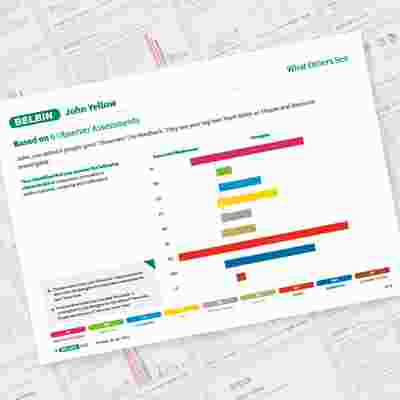At Belbin, we focus on strengths: the unique cocktail of behavioural contributions each person can bring to a team, and how we can best fit these contributions together to maximise engagement and performance and give the team what it needs for success at each stage.
But understanding our strengths also means shining a light on the obverse side of our strengths: the associated weaknesses.
Specialists are single-minded and autonomous. They know what needs to be done and are dedicated to learning about their subject. But in order to attain – and retain – this encyclopedic knowledge, they have to neglect other areas. There simply isn’t the bandwidth for them to know all parts of the business in depth. To others in the team, it may appear that the Specialist is only interested in their field, but this narrow focus is the trade-off for having their expertise in the team.
Each Belbin Team Role has its equivalent. The Resource Investigator’s enthusiasm for new ventures means that the old are often discarded. The Implementer’s focus on efficiency makes them inflexible to the kind of changes that will compromise their tried and trusted systems.
In his initial research and discovery of Team Roles, Dr Meredith Belbin found that the more prominent the strength, the more conspicuous the corresponding weakness was likely to be, hence celebrities and politicians, for example, come to be renowned for their quirks as much as for their talents.
When weaknesses operate alongside a Belbin Team Role strength, they are termed ‘allowable’. This means that the team can tolerate the weakness, because the corresponding strength is helping the team’s performance. However, there are two situations in which a weakness might be deemed ‘non-allowable’.
As Dr Belbin explains in his book, Team Roles at Work, we can accept the indecisiveness of a Teamworker who doesn’t want to risk offending or upsetting team members. But an indecisive Shaper ‘offers the worst of both worlds: a display of aggression will generate opposition and antagonism without compensation in terms of resulting action’.
In this case, the strength might be present, but the weakness is exaggerated to such an extent that the individual’s (and consequently the team’s) performance may be compromised. For example, a Monitor Evaluator’s scepticism is the result of taking a discerning approach, but cynicism without logic means that potentially beneficial ideas or proposals will also be rejected out of hand, which is a waste of the team’s resources.

Understanding weakness is integral to the Belbin process. When you ask others for Observer feedback, your Belbin Individual report offers an in-depth analysis of your weaknesses in relation to your Team Role strengths, so that you can check the alignment of the two.
But in order to access this crucial information, others in your team need to have the confidence to answer openly and honestly, understanding how the data will be collated and presented in the Report. Rather than attributing particular responses to individuals, Belbin focuses on the overall trends which allow you to discover how well you are articulating your strengths and where tweaks to your self-presentation might be appropriate. The objective is not to criticise how you work, but to give you key insights which can help you leverage your strengths to best effect.
In this example, John's strengths outweigh any perceived weaknesses, so are likely to be acceptable to the team, so long as they are not carried too far. Rather than our weaknesses working against us, ensuring that they are aligned with our strengths helps to clarify our Team Role contribution and gives others a coherent view of the part we play within the team.
It’s vital to understand that, in terms of Belbin theory, allowable weaknesses are not ‘areas for development’. They’re the expected trade-offs for having the strength present in the team.
We are six times more engaged when working to our strengths, but when focusing on ‘improving’ our weaknesses, engagement falls away.
We can expend lots of time and energy in trying to ‘manage away’ our weaknesses, but we’re likely to succeed only in inhibiting our strengths, when we should be honing them.
That said, how can the team mitigate any potentially detrimental effects those weaknesses might have on performance?
In a balanced team, Belbin Team Role opposites are well-placed to pick up the slack and manage one another’s weaknesses. The Resource Investigator’s lack of follow-up calls for a detail-focused Completer Finisher so that new leads are not abandoned. The Specialist’s narrow focus needs a broad-minded Co-ordinator to ensure that the team doesn’t become insular. Whilst responsibility for behaviour remains, of course, with the individual, a greater understanding of the dynamics at play can help grease the wheels.
Non-allowable weaknesses may need to be addressed by the team as a whole. Is the individual trying to play a role which doesn’t come naturally to them, and displaying only the negatives, as a result? Why does that person feel the need to play that role? Is there a Team Role gap, and if so, is there someone else who could fill it more easily?
When it comes to allowable weaknesses gone bad, there is no hard and fast rule: it is up to the team to set appropriate boundaries and to call out unacceptable behaviours when they are in evidence. Whilst this may not always be comfortable, familiarity with the language of Belbin (attaching the behaviour to the characteristics of a particular Team Role) can be enough to depersonalise conflict surrounding the issue.
If you’re looking to examine behaviours in your team, the Belbin reports are the place to start. If you’re working on resolving conflict, we offer workshops tailored to your requirements. To find out more about the numerous applications of Belbin (including feeding back Reports and using Belbin to enhance team performance), why not attend one of our practical days or just call us!

Before you can analyse your teams, you need to look at each individual's contribution. So, the first thing you will need to do is to generate a Belbin Individual report for each member of the team.
Find out more
Whether you're forming a new team, introducing new people to an existing team, or trying to resolve issues within a team, a Belbin Team report can help you to manage it.
Discover more
Belbin Team Roles are used to identify behavioural strengths and weaknesses in the workplace. Whether developing people, resolving conflict or fine-tuning high performance...
Read more